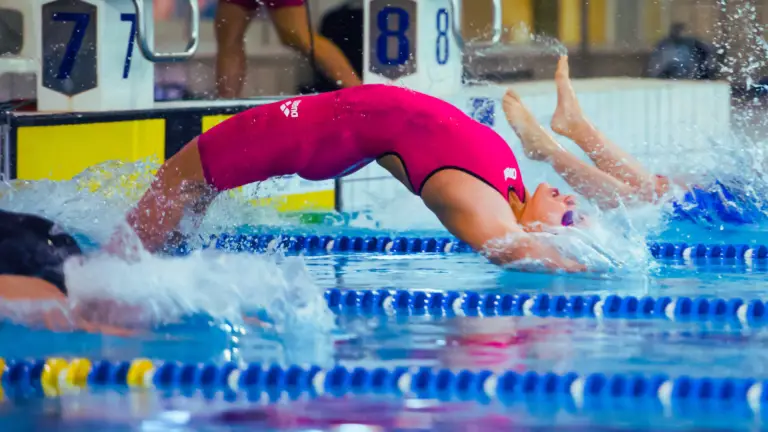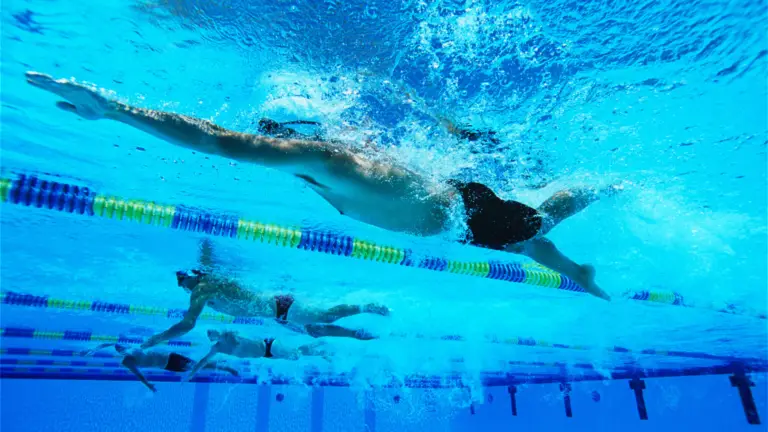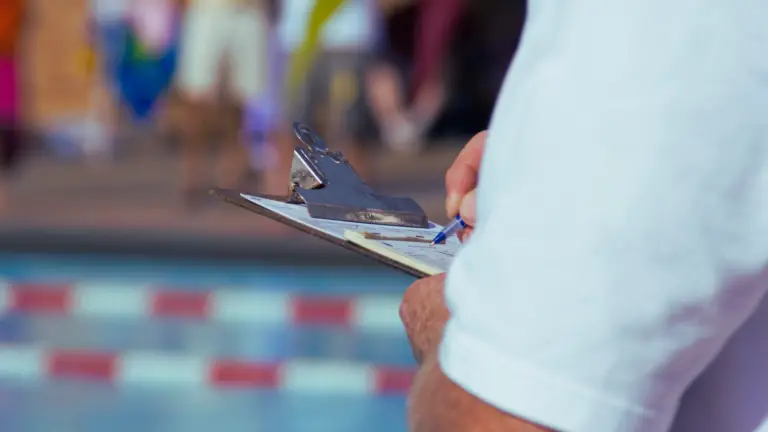The allure of a swim spa lies in its versatility, providing a space for relaxation akin to a hot tub while also offering a zone for vigorous exercise. However, like all pools and spas, it requires regular attention. One crucial maintenance duty every swim spa owner should be familiar with is how to drain it. In fact, draining your swim spa every six months is not just a recommendation—it’s a necessity for ensuring clean, safe water and optimal functionality. It’s truly the best of both worlds, allowing you to keep both your swim spa and hot tub in pristine condition and ready for use. Let’s learn how to drain a swim spa in this step-by-step guide!
Understanding Swim Spa Maintenance

When we talk about water-based leisure or exercise areas in our homes, the terminology can get a tad confusing. Let’s clarify the differences:
- Spa Pools: Smaller than swim spas, designed predominantly for relaxation. They use jets for therapeutic massage.
- Swim Spas: Larger than spa pools and allow for swimming against a continuous water current. It’s like having a small-scale pool with the benefits of a hot tub.
- Hot Tubs: Often synonymous with spa pools, but traditionally, they might not have jets and be heated with an external source.
| Spa Pool | Swim Spa | Hot Tub | |
|---|---|---|---|
| Size | Small | Medium-Large | Small |
| Purpose | Relaxation | Exercise & Relaxation | Relaxation |
| Jets | Usually Present | Present | Maybe Present |
Now, let’s delve into the core of our topic: draining. You might wonder, “Why is there a need to drain my swim spa?” The answer centers around water quality and care. Just like any other water body, over time, the water in your spa collects impurities. These can range from natural oils and lotions from our skin to external contaminants. Furthermore, while chemicals help maintain water cleanliness, they also accumulate, changing the water chemistry.
- Regular Maintenance: This involves routine checks, ensuring the water is clean, monitoring pH levels, and keeping your chemicals balanced. It’s your day-to-day or week-to-week checklist to ensure your spa is ready for use.
- Extensive Care: This is the deep cleaning process that includes draining your swim spa. It’s advisable to undertake this process every six months. It’s a chance to refresh the water, inspect the spa shell for damages, and give it a comprehensive clean. By following a regular maintenance schedule, you can reduce the frequency of these extensive care sessions.
Wondering when it’s time to drain your swim spa? Check out our comprehensive guide on how often to change your swim spa water.
In essence, maintaining your swim spa is a delicate balance between regular maintenance and more thorough care routines. By keeping this balance, you ensure a clean, safe, and enjoyable swim spa experience for you and your family.
Gathering the Essentials
Draining a swim spa isn’t a task you leap into unprepared. Before you start, ensure you have the following essentials on hand:
- Garden Hose: This will channel the water out from your swim spa to your drainage area.
- Submersible Pump: While not always necessary, it can speed up the drainage process significantly.
- Drainage Space: Ensure you have a suitable place for the water to drain, keeping in mind the gallons of water that will flow out.
Safety First
Electrical appliances and water don’t mix. Before starting any maintenance or drainage task, turn off the power to the swim spa. This step is crucial not only to protect the equipment but also to ensure personal safety. After shutting off the power, it’s good practice to lock the breaker to prevent any accidental power resumption.
A Step-by-Step Guide to Draining Your Swim Spa
Locate the Spigot
The spigot is your starting point when you’re looking to drain your swim spa. Typically located at the base or side of the spa, this outlet allows for the water to be safely channeled out. You may need to open up the side panel of your swim spa, so grab your drill or screwdriver.
- Description: Most spigots on swim spas are simple tap-like structures, sometimes with a threaded end to accommodate a garden hose.
- Usage Frequency: Depending on your maintenance schedule and how often you use your swim spa, you might find yourself using the spigot twice a year during the extensive care phase. However, it’s also useful for partial water changes or lowering water levels after heavy rain.
Connect Your Garden Hose
With the spigot located, the next step is to attach your garden hose.
- Ensure a secure connection to prevent any leaks or spills. If your spigot has a threaded end, it should be straightforward to connect your hose.
- Once connected, run the hose to your chosen drainage area. This could be a drain, a garden bed, or any other area that can handle the volume of water.
Using a Submersible Pump (if necessary)
While gravity and the spigot do a decent job of draining your spa, some spa owners prefer a quicker method.
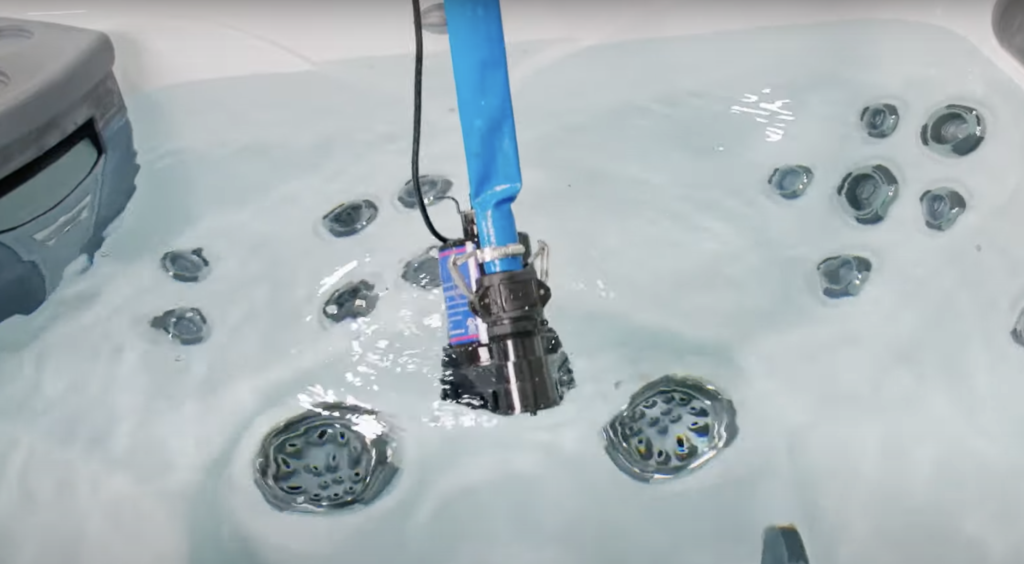
- Why Use a Sump Pump? The main reason is time. A submersible pump can drain water much faster than relying on gravity alone.
- Connection: Simply place the pump in the deepest part of your swim spa and connect its outlet hose to your drainage area. Ensure the pump is fully submerged before turning it on.
Monitor the Process
Draining the water can take some time, so while it might be tempting to leave it unattended, it’s essential to periodically check the process.
- Ensure the water is draining properly without overflowing your designated drainage area.
- As the water level drops, inspect the spa’s interior. Look for any residues, dirt, or blockages that might need cleaning while the spa is empty.
By following these steps, you’re ensuring a thorough and safe drainage of your swim spa. Remember, the goal isn’t just to remove the water but to provide a fresh start for clean and healthy spa water.
Post-Drainage Care
After draining, your swim spa isn’t quite ready for use yet. The post-drainage phase is as critical as the draining itself.
Cleaning the Shell
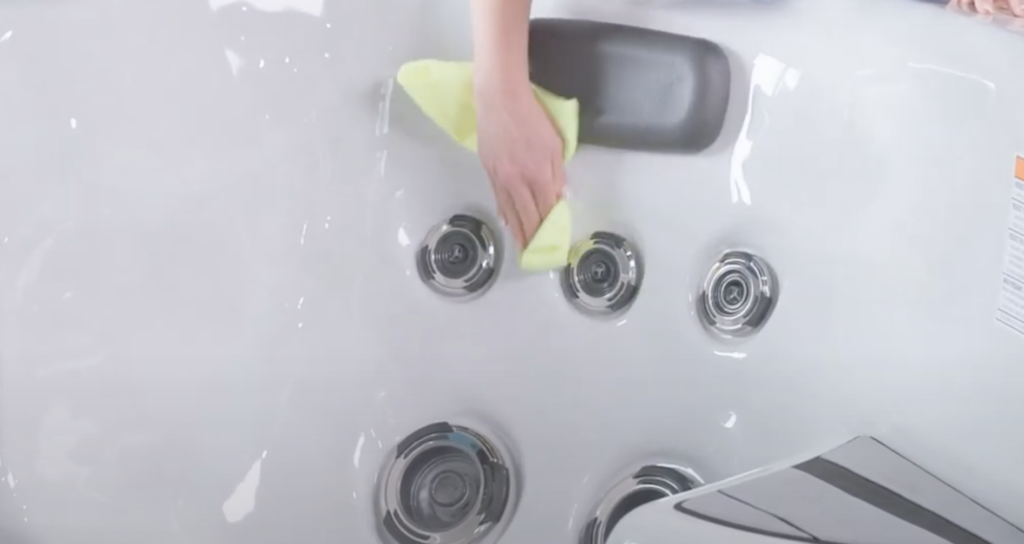
With the spa empty, it’s the perfect time to give the shell a thorough cleaning.
- Use a spa-specific cleaning product to scrub away any residue or buildup. This not only ensures a clean and fresh spa but can also extend the life of your swim spa’s shell.
- For stubborn spots, consider using a soft scrub brush. However, avoid anything abrasive that might scratch or damage the surface.
Refilling Your Swim Spa
Once you’ve cleaned the shell, it’s time to refill the swim spa.
- Ensure that you’re filling it with clean water. Depending on your local water quality, you might consider using a water filter during the refill process.
- After refilling, it’s crucial to balance the chemicals. Start by checking the pH levels, then adjust chlorine or bromine levels as necessary. Properly balanced water ensures the spa is safe for users and helps maintain the equipment.
Regular Water Care Routine
The key to a long-lasting swim spa is a consistent care routine.
- Regularly check the water quality and adjust chemical levels as needed.
- Clean or replace filters as per the manufacturer’s guidelines.
- Monitor the water level and top up as necessary to ensure pumps and jets run efficiently.
Bonus Tips for Swim Spa Owners
How the Type of Spa Affects Drainage Frequency
Different spa types might require varying maintenance schedules. For instance, a pure hot tub might need draining less often than a hybrid swim spa, especially if it’s used less frequently.
Swim Spas as Closed Systems
Unlike regular pools, swim spas are closed systems, which means they recycle their water. This system has benefits in terms of heating and energy efficiency but places more emphasis on regular water care and maintenance duties to keep the water clean.
When and How to Request a Quote for Professional Spa Maintenance
While many tasks can be DIY, occasionally, it’s beneficial to bring in the pros.
- If you’re unsure about chemical balance, water quality, or any other spa-related issues, consider seeking professional help.
- Many companies offer a free buyer’s guide or consultation. Request a quote and compare services to ensure your spa gets the best care.
Conclusion
Your swim spa is a significant investment, both in terms of finance and the joy it brings. To get the best of both worlds – fun and longevity – it’s vital to follow a regular maintenance schedule. By understanding the importance of drainage and post-drainage care, you set yourself up for a seamless and refreshing swim experience every time.
Remember, whether it’s a relaxing evening soak or a rigorous swim workout, the quality of your water plays a pivotal role in your enjoyment. Stay savvy, swim smart, and keep your swim spa in top shape.



